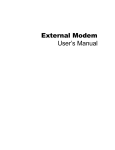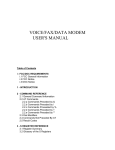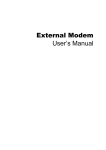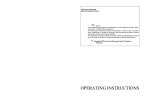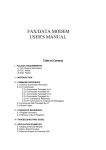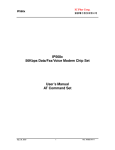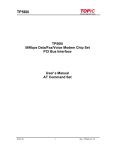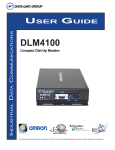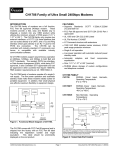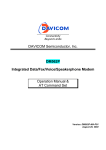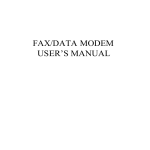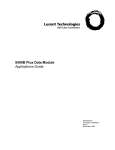Download FAX/DATA MODEM USER'S MANUAL
Transcript
FAX/DATA MODEM
USER'S MANUAL
Notice:
Bitcom is a registered trademark of BIT Software Inc.
BitFAX is a registered trademark of BIT Software Inc.
Crosstalk is a registered trademark of Microstuf Corporation.
Hayes is a trademark of Microcomputer Products Inc.
PCTALK is a registered trademark of Headlands Press Inc.
Smartcom is a trademark of Hayes Microcomputer Products.
Macintosh is a trademark of Apple Computer Corp.
i - FCC/DOC REQUIREMENTS
i.1 FCC General Information
i.2 FCC Notice
i.3 DOC Notice
1 - COMMAND REFERENCE
1.1 General Command Information
1.2 AT Commands
1.2.a Commands Preceded by &
1.2.b Commands Preceded by \
1.2.c Commands Preceded by %
1.3 Dial Modifiers
1.4 Commands Not Preceded By AT
1.5 Result Codes
2 - S REGISTER REFERENCE
2.1 Register Summary
2.2 Glossary of the S Registers
3 - TROUBLESHOOTING GUIDE
4 - APPLICATION EXAMPLES
4.1 Dialing a Remote Modem
4.2 Dial a Stored Number
4.3 Manual Answer an Incoming Call
4.4 Auto Answer an Incoming Call
4.5 Voice to Data Switching
A - CALLER ID COMMANDS
B - QUICK REFERENCE
C - GLOSSARY
D - ASCII CODE TABLE
i - FCC/DOC REQUIREMENTS
i.1 FCC General Information
The Federal Communications Commission (FCC) of the United States restricts specific uses of modems,
and places registration responsibilities on both the manufacturer and the individual user:
1. The modem may not be connected to a party line or to a coin operated telephone.
2. The modem manufacturer must make any repairs to the modem to maintain valid FCC registration.
3. Notification to the telephone company is no longer required prior to connecting registered
equipment, but upon request from the telephone company, the user shall tell the telephone company
which line the equipment is connected to as well as the registration number and ringer equivalence
number of the registered protective circuitry. FCC information is printed on a label on the bottom of
the modem.
i.2 FCC Notice
This equipment has been tested and found to comply with the limits for a digital device, pursuant to
Subpart B of Part 15 of the FCC rules. These limits are designed to provide reasonable protection against
harmful interference in a residential installed and used the instructions, may cause interference to radio
communications. However, there is no guarantee that interference will not occur in a particular
installation. If this equipment does cause harmful interference to radio or television reception, which can
be determined by turning the equipment off and on, the user is encouraged to try and correct the
interference by one or more of the following measures:
Reorient or relocate the receiving antenna.
Increase the separation between the equipment and receiver.
Connect the equipment into an outlet on a curcuit different from that to which the receiver is
connected.
Consult the dealer or an experienced radio/TV technician for help.
Shielded interconnect cables and a shielded power cord must be employed with this equipment to insure
compliance with the pertinent RF emission limits governing this device. Changes or modifications not
expressly approved by the manufacturer could void the user's authority to operate this equipment.
NOTE :
The manufacturer is not responsible for any radio or T.V. interference caused by
unauthorized modifications to this equipment. Such modifications could void the
user's authority to operate the equipment.
i.3 DOC Notice
Notice: The Canadian Department of Communications label identifies certified equipment. This
certification means that the equipment meets certain telecommunications network protective, operational
and safety requirements. The Department does not guarantee the equipment will operate to the user's
satisfaction.
Before installing this equipment, users should ensure that it is permissible to be connected to the facilities
of the local telecommunications company. The equipment must also be installed using an acceptable
method of connection. In some cases, the company's inside wiring associated with a single line individual
service may be extended by means of a certified connector assembly (telephone extension cord). The
customer should be aware that compliance with the above conditions may not prevent degradation of
service in some situations.
Repairs to certified equipment should be made by an authorized Canadian maintenance facility designated
by the supplier. Any repairs or alterations made by the user to this equipment, or equipment malfunctions,
may give the telecommunications company cause to request the user to disconnect the equipment.
Users should ensure for their own protection that the electrical ground connections
of the power utility, telephone lines and internal metallic water pipe system, if present, are connected
together. This precaution may be particularly important in rural areas.
Caution: Users should not attempt to make such connections themselves, but should contact the
appropriate electric inspection authority, or electrician, as appropriate.
The Load Number (LN) assigned to each terminal device denotes the percentage or the total load to be
connected to a telephone loop which is used by the device, to prevent overloading. The termination on a
loop may consist of any combination of devices subject only to the requirement that the total of the Load
Numbers of all the devices does not exceed 100.
1 - COMMAND REFERENCE
This chapter provides an alphabetized reference with examples for all commands for the modem. The
system of commands is depicted below in Figure 1-1.
To use these commands for dialing or configuring the modem, make sure the communications software
package you will be using lets you operate the modem through its internal commands. If your software
permits use of the modem's internal commands, read this chapter. If not, read your software user's manual
and ignore the rest of this manual.
1.1 General Command Information
Except for the A/ command and the +++ escape command described in Section 1.4, all commands must be
prefixed with the attention code AT. For instance, the A command (below) would be entered as: "AT
A<CR>". Without the AT prefix, the command line cannot be executed. Once entered, AT cannot be
deleted with the Backspace or Delete key.
More than one command can be placed on a single line and, if desired, separated with spaces for
readability. Once the carriage return (Enter) key is pressed, the command line is executed. A line with no
carriage return is ignored.
The modem accepts either upper or lower case characters in the command line and ignores any spaces
within or between commands. Typing errors can be corrected with the Backspace key. Exceptions are
noted in the description of specific commands.
Variables (r and x) are listed in italics. Punctuation symbols (, ; ! @) use as dial modifiers are listed
alphabetically according to their English names at the beginning of Section 1.3. Where two commands are
separated by a slash, either command will have the same effect. For example, if the command is listed as
B0/B, issuing either B0 or B will have the same effect.
1.2 AT Commands
A
Go On-line in Answer Mode
This command instructs the modem to go off-hook immediately and then make a handshake with the
remote modem. Handshaking is not available during leased line operation.
A is usually used to manually answer an incoming call or to switch from voice conversation to data
communication.
Bn
Select Protocol to 300 bps or 1200 bps
B0/B
Selects ITU-T 300 or ITU-T 1200 protocol once the command line prefix AT has been
entered at the 300 bps or 1200 bps data rate.
B1
Selects BELL 300 or BELL 212A protocol once the command line prefix AT has been
entered at the 300 or 1200 bps data rate. (default)
B2
Selects ITU-T V23, originate mode will transmit data at 75 bps and receive data at 1200
bps. Answer mode will transmit data at 1200 bps and receive data at 75 bps. The
command
N0 (Disable auto mode) must be selected.
Cn
Carrier Transmit Control
Controls the transmit carrier. The modem is preset to turn carrier on and off as necessary (the C1 option).
The signal is on when the modem is calling, or connected to a remote modem, and is off when it is not.
The C0 option is NOT valid.
D
C0
Not permitted; returns ERROR result code.
C1
Normal transmit carrier switching (preset).
Go On-line in Originate Mode
D instructs the modem to go off-hook immediately and automatically dial the number contained in the
dial string following D. The dial string may contain any of the dial modifiers contained in the following
section. The D command without a dial string is usually used to switch from voice conversation to data
communication or to call a remote modem in leased-line operation mode.
En
Hn
In
Mn
Command Echo
E0/E
Disables command echo.
E1
Enables command echo. (default)
Hang Up
H0/H
Goes on-hook. (hangs up)
H1
Goes off-hook. (ready to dial)
Identification
I0/I
Report the product code.
I1
Report the hardware checksum.
I2
Report "OK".
I3
Report firmware revision.
I4
Report OEM defined identifier string.
Monitor Speaker On/Off
M0/M
Speaker is always off.
Nn
On
M1
Speaker is off while receiving carrier. (default)
M2
Speaker is always on.
M3
Speaker disabled while dialing or receiving carrier.
Automode Enable
N0
Automode detection is disabled.
N1
Automode detection is enabled. This command is equivalent to F0. (default)
Return to On-Line Data Mode
O0
Enters on-line data mode without a retrain. Handling is determined by the Call
Establishment task. Generally, if a connection exists, this command connects the DTE
back to the remote modem after an escape (+++).
O1
Q
Enters on-line data mode with a retrain before returning to on-line data mode.
Result Code Display
Determines whether the modem sends the result codes to the DTE.
Sn
T
Q0
Allows the modem to send result codes to the DTE.
Q1
Prohibits the modem from sending result codes to the DTE.
Reading and Writing to S Registers
Sn?
Return the value of register n.
Sn=m
Set register n to value m.
Set Tone Dial as Default
Causes the modem to assume that all subsequent dial commands are tone dial.
Vn
Wn
Select Word or Digit Result Codes
V0/V
Displays result codes in digital format.
V1
Displays result codes in verbose format. (default)
Negotiation Progress Reporting
An additional set of result codes can be enabled with the W command to report progress of the negotiation
phase of error-correction mode. These codes report the carrier speed (300 bps - 2400 bps) and the error
correction protocol. These messagescan also be reported in either numeric or verbose form. For example,
both 77 and PROTOCOL:LAP-M indicate that the error correction protocol is LAP-M.
If the error correction link is negotiated and a connection is made, the appropriate CONNECT XXXX
message reports another connection speed.
W0
Report DTE speed only. After connection, there will be no message about what Error
Correction or Data Compression protocol is in use. (default)
Xn
W1
Report DCE speed, Error Correction/Data Compression protocol, and DTE speed.
W2
Report DCE speed only.
Extended Result Codes
This command selects which subset of the result messages will be used by the modem to inform the DTE
of the results of commands.
Blind dialing is enabled or disabled by country parameters. If the user wishes to enforce dial tone
detection, a "W" can be placed in the dial string(see D command). Note that the information below is
based upon the default implementation of the X results table.
If the modem is in facsimile mode (+FCLASS=1), the only message sent to indicate a connection is
CONNECT without a speed indication.
X0
Send OK, CONNECT, RING, NO CARRIER and NO ANSWER. Busy and Dial Tone
Detection are disabled.
Yn
Zn
X1
Send X0 messages and CONNECT speed.
X2
Send X1 messages and NO DIALTONE.
X3
Send X2 messages except NO DIALTONE, BUSY and RING BACK.
X4
Send all responses. (default)
Enables or Disables Long Space Disconnect
Y0/Y
Disables Long Space Disconnect. (default)
Y1
Enables Long Space Disconnect.
Reset
Zn, which must be placed at the end of the command line, resets the active configuration of the modem to
the stored configuration saved in nonvolatile RAM, hangs up the modem, and clears the command buffer.
Z0/Z
Resets the modem and loads stored configuration 0.
Z1
Resets the modem and loads stored configuration 1.
1.2.a Commands Preceded by &
&Cn
Select DCD Options
&C0/&C Maintains an ON status for the Data Carrier Detect (DCD). (default)
&C1
&Dn
Uses the actual state of the carrier from the remote modem for DCD.
DTR Option
&F
&Gn
&Kn
&D0
DTR is assumed on. (default)
&D1
DTR drop causes modem back to command mode without disconnecting.
&D2
DTR drop causes modem to hang up.
&D3
DTR drop causes modem to be initialized; &Y determines which profile is loaded.
Fetch Factory Configuration
&F0
Recall factory profile 0. (default)
&F1
Recall factory profile 1.
Set Guard Tone
&G0
Disable guard tone. (default)
&G1
Enable 550Hz guard tone.
&G2
Enable 1800Hz guard tone on answering modem.
DTE/Modem Flow Control
Determines how the modem controls the flow of data between the local DTE and the modem. When the
modem terminal buffer is nearly full, the modem will either send an XOFF or drop CTS to stop the data
flow. When the buffer is nearly empty, the modem will either send an XON or raise CTS to start the data
flow.
&Sn
&K0
Disable DTE/DCE flow control.
&K3
Enable RTS/CTS DTE/DCE flow control. (Default for data modem.)
&K4
Enables XON/XOFF DTE/DCE flow control.
&K5
Enables transparent XON/XOFF DTE/DCE flow control.
&K6
Enable RTS/CTS and XON/XOFF DTE/DCE flow control.
DSR Option
Determines whether DSR operates in accordance with the EIA-232-D specification or remains ON.
&Vn
&Wn
&S0
Force DSR on. (default)
&S1
DSR on at the start of handshaking and off after carrier loss.
View Configuration Profiles
&V0
Display active profile.
&V1
Display stored profiles.
&V2
Display stored telephone numbers.
Store the Current Configuration to Nonvolatile RAM
&Yn
&W0
Writes the current active configuration to profile 0 in nonvolatile RAM.
&W1
Writes the current active configuration to profile 1 in nonvolatile RAM.
Select the Default Profile
&Y0/&Y Uses profile 0 on power-up. (default)
&Y1
&Zn
Uses profile 1 on power-up.
Store Telephone Numbers (n=0to9)
&Zn Store one of four dial strings (including a telephone number) of up to 36 digits in nonvolatile RAM.
For example: to store the telephone number 002852117 to RAM location 1, issue the following command:
Command:AT&Z1=002852117<CR>
1.2.b Commands Proceded by \
\An
Select Maximum MNP Block Size
The modem will operate an MNP error corrected link using a maximum block size controlled by the
parameter supplied.The parameter value, if valid,is written to S40 bits 6 and 7.
\A0
64-character max. MNP block size.
\A1
128-character max. MNP Block size. (default)
\A2
192-character max. MNP block size.
\A3
256-character max. MNP block size.
Result Codes:
OK
ERROR
\Bn
n=0 to 3.
Otherwise.
Transmit Break to Remote
In non-error correction mode, the modem will transmit a break signal to the remote modem with a length
in multiples of 100ms according to parameter specified. If a number in excess of 9 is entered, 9 is used.
The command works in conjunction with the \K command.
In error correction mode,the modem will signal a break through the active error correction protocol,
giving no indication of the length.
\B1-\B9
Break length in 100ms units. (Default=3.) (Non-error corrected mode only.)
Result Codes:
OK
If connected in data modem mode.
NO CARRIER
If not connected or connected in fax modem mode.
Note: When the modem receives a break from the remote modem, break is passed to the DTE as
follows:In non-error correction mode direct, the break length is passed; in non-error correction mode
normal and in error correction mode,a 300 ms break is passed.
\Gn
Modem to Modem Flow Control (XON/XOFF)
Enables or disables modem flow control during a Normal Mode connection. Since Reliable Mode has its
own method of flow control, the \Gn command is ignored when error correction is selected.
However, DTE-to-modem flow control remains active during reliable link.
\Kn
\G0
Disable XON/XOFF flow control (modem to modem). (default)
\G1
Enable XON/XOFF flow control (modem to modem).
Break Control
Determines the modem's response when a BREAK is received from the DTE or the remote modem,
according to the following conditions:
When a BREAK is received from the DTE during Normal or MNP Mode:
\K0,2,4 Modem enters Command Mode (waiting for an AT command) without sending a
BREAK to the remote modem.
\K1
Modem clears the terminal and modem buffers.
\K3
Modem does not clear the buffers.
\K5
Modem sends a BREAK to the remote modem in sequence with any transmitted data.
(default)
When a BREAK is received from the remote modem during Normal Mode:
\K0,1
Modem clears the terminal and modem buffers.
\K2,4
Modem does not clear the buffers.
\K4,5
Modem sends a BREAK in sequence with any transmitted data.
When a BREAK is received from the DTE during Direct Mode:
\Nn
\K0,2,4
Modem sends a BREAK to the remote modem.
\K1,3,5
Modem sends a BREAK to the remote modem.
Operation Mode Control
Selects the operating mode to be used during connection.
\N0
Normal mode; speed control without error correction.
\N1
Plain mode; no speed control and no error correction.
\N2
Reliable mode.
\N3
Auto-reliable mode. (default)
\N4
LAPM error correction only.
\N5
MNP error correction only.
1.2.c Commands Preceded by %
%C
Enable/Disable Data Compression
Enables or disable data compression negotiation.The modem can only perform data compression on an
error corrected link.The parameter value, if valid, is written to S41 bits 0 and 1.
%C0
Disable data compression.
%C1
Enable MNP 5 compression.
%C2
Enable V.42 bis compression.
%C3
Enable both V.42 bis and MNP 5. (default)
Result Codes:
OK
ERROR
%En
n=0,1,2,or 3.
otherwise.
Enable/Disable Line Quality Monitor and Auto-Retrain or Fallback/Fall Forward
Control whether or not the modem will automatically monitor the line quality and request a retrain
(%E1) or fall back when quality is insufficient or fall forward when line quality is sufficient (%E2).
Applies to dial-up line only. The parameter value valid, is written to S41 bits 2 and 6. If enable, the
modem attempts to retrain for a maximum of 30 seconds.
%Q
%E0
Disable auto-retrain.
%E1
Enable auto-retrain.
%E2
Enable auto-retrain and fallback. (default)
%E3
Enable auto-retrain and fast hang up.
Line Signal Quality
Reports the line signal quality (DAA dependent). Returns the higher order byte of the EQM value. Based
on the EQM value, retain or fallback/fall forward may be initiated if enabled by %E1 or %E2.
1.3 Dial Modifiers
This section describes all of the dial modifiers which are used in dial strings.
@
Answer
"@", placed after a phone number, this modifier tells the modem to wait for 5 seconds of silence before
dialing the next number in the dial string. @ is usually used to access a secure computer system that
provides a silent answer as permission for further entrance.
,
Pause
",", placed anywhere in the dial string, tells the modem to pause for the number of seconds specified by Sregister S8 before processing the rest of the dial string.
!
Initiate a Hookflash
"!", placed anywhere in the dial string, tells the modem to initiate a hookflash, which means to hang up
for 0.5 seconds and then go off-hook again before processing the rest of the dial string. This modifier
allows access to PBX features like call transferring.
;
Return to Command State after Dialing
";", which must be placed at the end of the dial string, returns to the command state after dialing the
number placed ahead of it. A long telephone number would overflow the 40 character command buffer if
placed all in one command line, so it must be broken into two or more command lines. Each part includes
part of the number, and all but the last command line end with the ";" followed by a carriage return.
^
Tone Control
Toggles calling tone enable/disable:applicable to current dial attempt only.
L
Re-dial Last Number
The modem will re-dial the last valid telephone number. The L must be immediately after the D with all
the following characters ignored.
S
Dial a Stored Number
S is used to dial one of four numbers stored in nonvolatile memory. For example, instead of entering a dial
string, you can use this command:
Command: ATDTS=1<CR>
S=(0-9)
T
Touchtone Dialing
T, placed ahead of a number, tells the modem to dial a number using touchtone dialing.
W
Wait for Dialtone
W, placed after a number, tells the modem to wait up to 30 seconds to detect a one-second continuous
dialtone before dialing the next number. W is most often used in a PBX system to wait for the dialtone of
an outside telephone line.
1.4 Commands Not Proceded by AT
Two commands, A/ and +++, are neither preceded by the attention code AT nor followed by a carriage
return.
A/
Repeat Command
A/ repeats the execution of the last command line stored in the command buffer. If the last command line
is invalid, the ERROR result code will appear on the screen. Note that A/ cannot be preceded by AT; if it
is, ERROR will appear on the screen.
+++
Escape
+++ returns to the on-line command state (command state without breaking the established connection)
from the on-line state.
To escape, stop transmitting data, wait at least one escape guard time (the default time is one second), and
then enter three consecutive escape characters (the default character is +). After one more escape guard
time (one second), the modem returns to the command state and sends the OK result code to the screen.
Note that the escape command is the only command that can be recognized by the modem in the on-line
state; it cannot be recognized in the command state.
1.5 Result Codes
The modem sends a response to the user via the screen after a command is issued. As shown in the figure
below, there are two forms for each result code.
Long Form
OK
CONNECT
RING
NO CARRIER
ERROR
CONNECT 1200
NO DIALTONE
BUSY
NO ANSWER
Short Form
0
1
2
3
4
5
6
7
8
CONNECT 600
CONNECT 2400
CONNECT 4800
CONNECT 9600
CONNECT 7200
CONNECT 12000
CONNECT 14400
CONNECT 19200
CONNECT 38400
CONNECT 57600
CONNECT 115200
CONNECT 2880
CONNECT 300
CONNECT 1200TX
/75RX
CONNECT 75TX
/1200RX
CONNECT 110
RING BACK
+FCERROR
FAX
DATA
9
10
11
12
13
14
15
16
17
18
19
20
21
22
Description
Modem successfully executed an AT command
A connection established
Modem detected an incoming call
Modem lost or could not detect a remote carrier signal within the register S7 time
Modem detected an error in an AT command
Connection at 1200 bps
Modem did not detect a dial tone within 5 seconds after off-hook
Modem detected a busy tone
Modem did not detect 5 seconds of silence when using the @ dial modifier in the
dial command
Connection at 600 bps
Connection at 2400 bps
Connection at 4800 bps
Connection at 9600 bps
Connection at 7200 bps
Connection at 12000 bps
Connection at 14400 bps
Connection at 19200 bps
Connection at 38400 bps
Connection at 57600 bps
Connection at 115200 bps
Connection at 2880 bps
Connection at 300 bps
Connection at transmit 1200/receive 75 bps
23
Connection at transmit 75/receive 1200 bps
24
25
+F4
33
35
Connection at 110 bps
Ring Back signal detected
Error occurred in Class 1 fax operation
Fax modem connection established
Data modem connection established
CARRIER 300
CARRIER 1200/75
CARRIER 75/1200
CARRIER 1200
CARRIER 2400
CARRIER 4800
CARRIER 7200
CARRIER 9600
CARRIER 12000
CARRIER 14400
CARRIER 16800
CARRIER 19200
CARRIER 21600
CARRIER 24000
CARRIER 26400
CARRIER 28800
CONNECT 16800
CONNECT 21600
CONNECT 24000
CONNECT 26400
COMPRESSION:
CLASS 5
COMPRESSION:
V.42bis
COMPRESSION:
NONE
PROTOCOL:NONE
PROTOCOL:LAPM
PROTOCOL:ALT
CARRIER 31200
CARRIER 33600
CONNECT 31200
CONNECT 33600
CARRIER 32000
CARRIER 34000
CARRIER 36000
CARRIER 38000
CARRIER 40000
CARRIER 42000
CARRIER 44000
CARRIER 46000
CARRIER 48000
CARRIER 50000
CARRIER 52000
CARRIER 54000
CARRIER 56000
CARRIER 58000
CARRIER 60000
CARRIER 28000
CARRIER 29333
CARRIER 30666
CARRIER 33333
CARRIER 34666
CARRIER 37333
CARRIER 38666
CARRIER 41333
CARRIER 42666
CARRIER 45333
CARRIER 46666
CARRIER 49333
CARRIER 50666
CARRIER 53333
CARRIER 54666
40
44
45
46
47
48
49
50
51
52
53
54
55
56
57
58
59
61
62
63
66
67
Carrier rate of 300 bps
Carrier rate of transmit 1200/receive 75 bps
Carrier rate of transmit 75/receive 1200 bps
Carrier rate of 1200 bps
Carrier rate of 2400 bps
Carrier rate of 4800 bps
Carrier rate of 7200 bps
Carrier rate of 9600 bps
Carrier rate of 12000 bps
Carrier rate of 14400 bps
Carrier rate of 16800 bps
Carrier rate of 19200 bps
Carrier rate of 21600 bps
Carrier rate of 24000 bps
Carrier rate of 26400 bps
Carrier rate of 28800 bps
Connection at 16800 bps
Connection at 21600 bps
Connection at 24000 bps
Connection at 26400 bps
MNP Class 5 data compression connection
established
V.42bis data compression connection established
69
Connection established without data compression
76
77
80
90
91
95
96
97
98
99
100
101
102
103
104
105
106
107
108
109
110
111
112
113
114
115
116
117
118
119
120
121
122
123
124
125
126
Connection established without error correction
V.42/LAPM error correction connection established
MNP 3-4 error correction connection established
Carrier rate of 31200 bps
Carrier rate of 33600 bps
Connection at 31200 bps
Connection at 33600 bps
Connection at 32000 bps
Connection at 34000 bps
Connection at 36000 bps
Connection at 38000 bps
Connection at 40000 bps
Connection at 42000 bps
Connection at 44000 bps
Connection at 46000 bps
Connection at 48000 bps
Connection at 50000 bps
Connection at 52000 bps
Connection at 54000 bps
Connection at 56000 bps
Connection at 58000 bps
Connection at 60000 bps
Connection at 28000 bps
Connection at 29333 bps
Connection at 30666 bps
Connection at 33333 bps
Connection at 34666 bps
Connection at 37333 bps
Connection at 38666 bps
Connection at 41333 bps
Connection at 42666 bps
Connection at 45333 bps
Connection at 46666 bps
Connection at 49333 bps
Connection at 50666 bps
Connection at 53333 bps
Connection at 54666 bps
2 - S REGISTER REFERENCE
Your modem has status registers. These registers are memory locations inside your modem which control
your modem's operation. You usually do not have to worry about setting any register because the default
values work for most applications.
The S registers are summarized in Fig. 2-1, along with their default values. Registers denoted with an " *
" may be stored in one of the two user profiles by entering the &Wn command. One of these profiles may
be loaded at any time by using the Zn command.
The factory default values are stored in ROM and are loaded into the active configuration at power-up or
by the Zn command. In addition, the designated default profile is subsequently loaded, and may change
some of the factory default values.
The designated default profile can be changed by entering the &Yn command, where 'n' is one of the two
possible user profiles. The factory defaults can be loaded at any time by entering the &F command.
2.1 S Register Summary
The following chart summarizes your modem's registers:
Reg.# Range
S0
0 - 255
S1
0 - 255
S2
0 - 127
S3
0 - 127
S4
0 - 127
S5
0 - 127
S6
2 - 255
S7
1 - 255
S8
0 - 255
S9
1 - 255
S10
1 - 255
S11
50 - 255
S12
0 - 255
S13
S14
S15
S16
S17
S18
0 - 255
S19
S20
S21
S22
S23
S24
S25
0 - 255
S26
S27
S28
S30
0 - 255
S32
0 - 255
S33
0 - 255
S34
0 - 13
S35
0-5
S36
S37
S38
0 - 255
Unit
rings
rings
ASCII
ASCII
ASCII
ASCII
seconds
seconds
seconds
1/10 sec.
1/10 sec.
1/1000 sec.
1/50 sec.
Reserved
Reserved
Reserved
Reserved
Reserved
seconds
Reserved
Reserved
Reserved
Reserved
Reserved
Reserved
seconds
Reserved
Reserved
Reserved
10 s
ASCII
ASCII
0
0
43
13
10
8
2
50*
2*
6*
14*
95
50*
Dec
00h
00h
2Bh
0Dh
0Ah
08h
02h
32h
02h
06h
0Eh
5Fh
32h
Default
Hex
Description
Number of rings before auto-answer
Ring count
Escape character code
Command terminator (<CR> character)
Line feed character
Backspace character
Wait time for blind dialing ( Default)
Wait time for carrier after dial
Pause time for comma (dial delay)
Carrier detect response time
Lost carrier to hang-up delay
DTMF Tone Duration
Escape code timing
0*
00h
Test mode timer
5*
05h
Dalay to DTR
0*
17
19
13*
0
00h
11h
13h
0Dh
00h
Disconnect Inactivity Timer
XON Character
XOFF Character
V.34 Data Rate(bit-rate) ( Default)
V.34 Symbol RAte(baud-rate)
Reserved
seconds
0*
20*
Desired DCE Speed
Delay before forced disconnect (
Default)
S39
S40
S41
S42
S43
S44
S45
S46
S47
S48
S82
S86
S91
0 - 15
Attenuation
Reserved
Reserved
Reserved
Reserved
Reserved
Reserved
Reserved
Reserved
Reserved
Reserved
Reserved
dBm
11
Call Failure Reason Code
0Bh
PSTN Transmit
Level
Fig. 2-1 S-Register Summary
2.2 Glossary of the S Registers
S0
Number of Rings Before Auto Answer
S0 determines the number of rings that must be received before the modem automatically answers an
incoming call. For example, when S0=3, the modem automatically answers after the third ring. When
S0=0, the modem does not automatically answer an incoming call; it stays on-hook until the A command
is issued manually to answer the incoming call.
Range:
Default:
S1
0 - 255 rings
0
Ring Count
S1 automatically increments its value by one each time the modem receives a ring while in the command
state. S1 is reset to zero if no ring is detected within 8 seconds.
Range:
Default:
S2
0 - 255 rings
0
ASCII Value of Escape Character
S2 stores the ASCII value of the escape character. Setting register S2 to a value greater than 127 disables
the escape command and you cannot return to the command state. With escape disabled, in the on-line
state the modem cannot hang up until the power is turned off or the remote modem hangs up.
Range:
Default:
S3
0 - 127, ASCII decimal.
43 (+)
ASCII Value of Carriage Return
S3 stores the ASCII value of the carriage return character. (Pertains to asynchronous operation only.)
Range:
Default:
0 - 127, ASCII decimal.
13
S4
ASCII Value of Line Feed Character
S4 stores the ASCII value of the line feed character, if your computer does not recognize the default as a
line feed, change the value. A value greater than 127 disables the line feed. When disabled, the line feed
character that precedes or follows a result code is canceled.(Pertains to asynchronous operation only.)
Range:
Default:
S5
0 - 127, ASCII decimal.
10 (Line Feed)
ASCII Value of Backspace Character
S5 stores the ASCII value of the backspace character. The backspace is used to edit a command line. If
your computer does not recognize the default as a backspace, change the value. (Pertains to asynchronous
operation only.)
Set S5 to any value from 0 to 31 or 127. Do not set it to any value from 32 through 126 because these
values correspond to printable ASCII characters. A value greater than 127 disable the backspace and
makes it impossible to edit a command line.
Range:
Default:
S6
0 - 127, ASCII decimal.
8 (Backspace)
Wait Time before Blind Dialing
S6 controls how long the modem waits after it goes off-hook before it dials the first digit of the telephone
number. The modem always pauses for at least 2 seconds, even if S6 is set to less than two seconds.
Range:
Default:
(
S7
2 - 255 seconds.
2
Default)
Wait for Carrier after Dial
S7 controls how long the modem waits for a carrier signal from a remote modem after originating a call
or from the calling modem after going off-hook when answering a call.
S7 also controls how long the modem waits for a one-second continuous dialtone after dialing a number
followed by the W dial modifier. If the modem detects a one-second continuous dialtone within the
specified wait time, it proceeds to dial.
Range:
Default:
S8
1 - 255 seconds.
50
Pause Time for Comma
S8 controls how long the modem pauses when a comma ", " is encountered in a dial string while
executing a dial command.
Range:
0 - 255 seconds.
Default:
S9
2
Carrier Detect Response Time
S9 determines how long a carrier signal must be present for the modem to confirm it. The longer the
response time, the easier it is for the modem to correctly recognize a carrier without mistaking other
signals or transient noise on the line as a carrier.
Range:
Default:
S10
1 - 255 tenths of a second.
6 (0.6 second)
Delay between Loss of Carrier and Hang-Up
S10 determines the delay time between the loss of a carrier from the remote modem and hang-up. This
allows for a temporary loss of carrier without causing the local modem to disconnect. When S10 is set to
255, the modem functions as if a carrier is always present.
The actual interval the modem waits before disconnecting is the value in S10 minus the value in S9.
Therefore, the value in S10 must be greater than that in S9, or else the modem disconnects before it
recognizes the carrier.
Range:
Default:
S11
1 - 255 tenths of a second.
14 (1.4 seconds)
DTMF (Touch-tone) Tone Duration
S11 determines the duration and spacing of tones for Dual Tone Multifrequency (DTMF) dialing. This
value has no effect on pulse dialing.
Range:
Default:
S12
50 - 255 milliseconds.
95
Escape Guard Time
S12 determines the escape guard time. The escape guard time is the minimum waiting time required
before and after entering the escape code (three consecutive escape characters) in the on-line state. It is
also the maximum waiting time allowed between any two consecutive escape characters. If the waiting
time before or after the escape code is shorter than the guard time, or if the waiting time between
consecutive escape characters is longer than the guard time, then the modem does not recognize the
escape command and stays on-line.
If the escape guard time is set at 0 second, it is impossible to return the modem to command state.
Range:
Default:
S13
Reserved
S14
Reserved
0 - 255 1/50 of a second.
50 (1 second)
S15
Reserved
S16
Reserved
S17
Reserved
S18
Test Timer
The test timer determines how long tests are performed. The modem automatically ends the test when the
test time is expired. The default value of 000 disables the test timer. When the timer is thus disabled, all
tests must be ended with the &T0 command.
Range:
Default:
S19
Reserved
S20
Reserved
S21
Reserved
S22
Reserved
S23
Reserved
S24
Reserved
S25
Delay to DTR
0 - 255 seconds.
0
S25 serves two purposes. When the modem is operating in synchronous mode 1, the value assigned to S25
specifies the length of time the modem waits after a connection has been made before examining DTR.
This allows the modem to ignore an ON-to-OFF transition of DTR, giving the user time to disconnect the
modem from the asynchronous terminal and attach it to a synchronous terminal, without forcing the
modem back to the asynchronous command mode. During this time, the value for S25 is read in whole
seconds.
In all other modes, and after call establishment in synchronous modes I and 4, the value is read in 1 /100
seconds. In any mode, a change in DTR (ON or OFF) that persists for a period shorter than the value held
in S25 is ignored by the modem while it is in data mode.
Range:
0 - 255 (1 second for synchronous mode 1;
0.01 second otherwise)
Default:
5
S26
Reserved
S27
Reserved
S28
Reserved
S30
Inactivity Disconnect Timer
This register determines the length of time, in seconds, the modem waits before
disconnecting when no data is sent or received. This only operates in &Q5 and
&Q6 modes, a value of 0 in this register disables the timer.
Range:
Default:
S32
XON Character
Range:
Default:
S33
0 - 255, ASCII decimal
17
XOFF Character
Range:
Default:
S34
0 - 255 tenths of a second
0 (disable)
0 - 255, ASCII decimal
19
56K Data Rate (bit-rate)
Set the maximum bit rate for 56K.
Range:
0 - 32
bit rate = 32000bps + S34 * 2000bps
V.34 Data Rate (bit-rate)
Set the maximum bit rate for V.34.
Range:
Default:
(
S35
0 - 8(2400 baud)
1-10(3000 baud)
1-11(3200 baud)
1-13(3429 baud)
bit rate = ((S34) + 1) * 2000bps
13 (33600 bps)
Default)
V.34 Symbol Rate(baud-rate)
Set the maximum baud rate for V.34.
Range:
Default:
0-5
0 - 2400 baud
1 - 2743 baud (N/A)
2 - 2800 baud (N/A)
3 - 3000 baud
4 - 3200 baud
5 - 3429 baud (N/A until V.34bis)
0 (2400 baud)
S36
Reserved
S37
Desired Line Connection Speed
Default:
0
Desired line connection speed. This is interlinked with the Fn command. If an invalid number is entered,
the number is accepted into the register, but S37 will act as if the default value has been entered.
0 = Attempt to connect at the highest speed. (default)
3 = Attempt to connect at 300 bps.
4 = Attempt to connect at 1200 bps.
6 = Attempt to connect at 2400 bps.
7 = Attempt to connect at 4800 bps.
8 = Attempt to connect at 7200 bps.
9 = Attempt to connect at 9600 bps.
10 = Attempt to connect at 12000 bps.
11 = Attempt to connect at 14400 bps.
12 = Attempt to connect at V.34.
S38
Delay Before Forced-Disconnect
This register controls how long the modem waits, after receiving the ATH command or loss of DTR,
before it disconnects from the telephone line. When connected in an error-corrected mode, you can use
this register to ensure that all data is transmitted from the modem's buffer before the modem disconnects.
If you set S38 between 0 and 254, the modem waits that number of seconds for the remote modem to
acknowledge all data before it disconnects. If you set S38 to 255, the modem waits indefinitely for the
remote modem to acknowledge all data.
Range:
Default:
S39
Reserved
S40
Reserved
S41
Reserved
S42
Reserved
0 - 255 seconds
0 ( Default)
S43
Reserved
S44
Reserved
S45
Reserved
S46
Reserved
S47
Reserved
S48
Reserved
S82
Reserved
S86
Call Failure Reason Code
0 - Normal disconnect; no error.
4 - Loss of carrier.
5 - V.42 negotiation failed to detect an error correction modem at remote end.
6 - No response to complete negotiation.
9 - No common protocol.
12 - Remote initiated a normal disconnect.
13 - Remote modem did not respond after 10 message retransmissions.
14 - Protocol violation.
15 - Compression failure.
20 - Hang up by inactivity time out.
S91
PSTN Transmit Attenuation Level
Sets the transmit attenuation level from 0 to 15 dBm for the PSTN mode resulting in a transmit level from
0 to -15 dBm.
Range:
Default:
0 to 15 dBm (Corresponding to 0 to -15 dBm transmit level).
11 (-10 dBm transmit level).
3 - TROUBLE SHOOTING
This chapter describes common problems in the installation, configuration and regular usage of your
Fax/Data Modem. To test the Fax/Data Modem, a communication software package is needed and the
package must include a mode that allows you to operate your Fax/Data Modem by directly issuing internal
commands to the modem.
Follow the procedures in the following sections to resolve these common problems:
No Response From Your Modem
1. If you are using the internal add-on card modems, make sure that the COM port address you have
set your modem to corresponds to the appropriate selection in the communications software which
you are using.
2. Issue the ATZ command to reset your modem. The returned result code should be "0" or "OK"
depending on what communications program you are using. Your modem is OK if you get one of
these responses. If there is no response after issuing the ATZ<CR>, continue to the next step.
3. Check if there are any other interface cards in your computer that use the same COM port address
as your modem. If so, you must set your modem to another COM port address. (Keep in mind that
on most systems, only two COM ports are available. One of them must be used as either 1 or 3,
while the other must be used as 2 or 4.) For example, if a mouse is set to COM 1, your modem
should be set to COM2 or COM4. Continue to the next step if the COM port address is OK.
4. Issue the command: AT&F&W <CR>, if a "0" or "OK" result code is displayed on the screen,
your modem is OK. Otherwise, contact your dealer for assistance.
Your Modem Does Not Dial Out
Make sure that your modem responds normally. If you can communicate through the keyboard, check
whether the modem is properly connected to the phone line.
Your Modem Does Not Connect After It Has Dialed a Phone Number
The problem may have several causes. The phone line may be too noisy or the telephone cord may be
poor. Try the line with a regular phone. Also the remote modem may not recognize your modem's baud
rate.
Your Can't Transmit After You Have Connected to the Remote Modem
In this case, check the communication parameters of the remote modem, then configure your software to
the same number of data bits, stop bit, and parity.
4 - APPLICATION EXAMPLES
4.1 Dialing a Remote Modem
Command line: ATDP9WT002, (886)-7128423<CR>
This command line instruct the modem to dial a remote modem through a PBX. The modem first use
pulse dialing to dial 9 (the access code of the PBX), wait for outside dial tone, and then use touch tone
dialing to dial 002 once a one-second continuous dial tone is detected within 30 seconds, pause for 2
seconds (if S8=2) and then dial 8867128423.
4.2 Dial a Stored Number
Command line: AT&Z2=T03,709394<CR>
Command line: ATDS=2<CR>
The first command line store the dial string T03, 709394 to the 3rd location in NVRAM. Afterwards you
can use the second command line to dial this stored number. The dial string T03, 709394 will appear on
the screen to indicate the number being dialed.
4.3 Manual Answer an Incoming Call
Command line: ATA <CR>
The factory setting of the S-register S0 is S0=0. This condition disables the auto answer capability so that
you must issue an ATA command to answer a call. At power up, your modem always monitors if there are
incoming rings. If incoming rings are detected, your modem will display result codes on the screen as :
RING
:
:
RING
Seeing that, you may issue the ATA command to answer the call. This command must be entered within
the quiet interval between any two rings.
4.4 Auto Answer an Incoming Call
Command line: AT S0=2 &W &Y <CR>
Auto answer can be enabled by changing the setting of the S-register S0 to a value between 1 and 255. In
the above command line, S0=2 instructs the modem to answer an incoming call automatically after the
2nd ring. The &W command writes this configuration to profile 0 in NVRAM. &Y command instruct the
modem to load profile 0 as the active configuration on power-up. The last two commands make S0=2 the
default value at power-up or reset.
This example also shows the insertion of space between two neighboring commands to make the
command line more readable.
4.5 Voice to Data Switching
Command line: ATA <CR> or ATX1D <CR>
If you are talking with a remote modem user through the telephone set and want to initiate data
communication with the remote modem, follow the procedures below:
1. You or the remote user issue an ATA command first to switch to data communication.
2. When the person on the other end hears an answer tone from the phone, issues an ATX1D
command (X1 to disable the dial tone monitor) to instruct the modem to go off-hook and wait for a
carrier. If connection is successful, the CONNECT XXXX result code will be displayed on the
screen. Now you can hang up your phone and begin data communication with the remote modem.
A - CALLER ID COMMANDS(Option)
#CIDn Caller ID(Enables or Disables Caller ID)
This command only apply to models which support the Caller ID function.
#CID=0
Disables Caller ID. (Default)
#CID=1 Enables Caller ID with formatted presentation to the DTE. The modem will present the date
items in a <Tag><Value> pair format. The expected pairs are data, time, caller code
(telephone
number), and name.
#CID=2 Enables Caller ID with unformatted presentation to the DTE. The modem will present the
entire packet of information, excluding the leading U's, in ASCII printable hex numbers.
Result Codes:
OK
n=0 or 2.
ERROR Otherwise.
Inquiries:
#CID?
Retrieves the current Caller ID mode from the modem.
#CID=? Returns the mode capabilities of the modem in a list with each element separated by
commas.
Formatted Form Reporting
The modem presents the data in the <tag>=<value> pair format as described in the table below. Spaces
are present on both sides of the equal sign.
TAG
Description
DATE
DATE=MMDD where MM is the month number (01 to 12) and DD is the day number
(01..31).
TIME
59).
TIME=HHMM where HH is the hour number (00 to 23) and MM is the minute number (00 to
NMBR
NMBR=<number> or P or O where <number> is the telephone number of the caller, where
P indicates that the calling number information is not available since the orginating caller
has
requested private service, and where O indicates that the calling number information is
not available or
out of service at the calling location.
NAME
NAME=<listing name> where <listing name> is the subscription name.
MESG
MESG=<data tag><length of message><data><checksum> in printable ASCII hex
numbers. This tag indicates a data item not listed above. The message is only possible for
Multiple Message Format.
Notes:
1. The modem does not present any Caller ID information if the DCE detects a checksum error in the
Caller ID packet.
2. In the event of an unrecognized data tag, the modem will present the data in ASCII hex numbers
following the MESG tag.
Example of Formatted Form Reporting
1. The following example illustrates the standard Caller ID message packet.
RING
DATE=0321
TIME=1405
NMBR=504551234
NAME=ANOTHER
RING
RING
2. The following example illustrates the case where the tag of the packet is not recognized by the modem.
RING
MESG=06034242431
RING
RING
Unformatted Form Reporting
The modem presents all information and packet control information found in the message. The modem,
however, excludes the leading U's. (Channel seizure information) from the presentation. The packet is
presented in ASCII printable hex munbers, the modem does not insert spaces, or line feeds, for formatting
between bytes or words of the packet. The modem does not detect the checksum of the packet.
Example of Unformatted From Reporting
RING
0412303332323234303539313435353132333435
RING
RING
Features
Data Rates(bps)
56000, 54667, 53333, 52000, 50667, 49333, 48000, 46667, 45333, 42667, 41333, 40000,
38667,37333, 36000, 34667, 33333, 32000, 30667, 29333, 28000 bps (ITU-T V.90 receive only)
56000, 54000, 52000, 50000, 48000, 46000, 44000, 42000, 40000, 38000, 36000, 34000, 32000
bps. ( K56Flex receive only)
33600, 31200, 28800, 26400, 24000, 21600, 19200, 16800, 14400, 12000, 9600, 7200, 4800,
2400, 1200, 300bps
Compatibility
(Data)
ITU-V.90, ITU-T V.34, V.32 bis, V.32, V.22 bis, V.23, V.22, and V.21
Bell: 212A and 103, Rockwell V.Fast Class, K56flex
(Fax)
ITU-T V.17, V.29, V.27 ter, and V.21 ch 2
Command Set
Enhanced 'AT' command set, Fax Class 1 command
Flow Control
Xon/Xoff, Hardware RTS/CTS
Data Compression
V.42bis, MNP5
Error Correction
V.42, MNP 2-4
General Features
Auto Fallback
AT Commands
Auto Selection of COM Port and IRA settings
Automatic Answering
Signal Quality Monitoring and Auto Retrain
Single Crystal Design
Data/Fax/Voice Auto Detection
Automode
High throughput Virtual UART, DTE rate up to 115200 ISA Bus Interface
Low Power Consumption
Opearting System Compatibility
Windows 95
Windows 98
Windows NT 4.0
Operation
Full-or Half-duplex 56000bps with 54667, 54000, 53333, 52000, 50000 ,50667, 49333, 48000,
46667, 46000, 45333, 44000, 42667, 42000, 41333, 40000, 38667, 38000, 37333, 36000, 34667,
34000, 33600, 33333, 32000, 30667, 31200, 29333, 28000, 26400, 24000, 21600, 19200, 16800,
14400, 12000, 9600, 7200, 4800, 2400, 1200, and 300bps auto fallback
Test Modes
Analog loopback, local digital loopback, and remote digital loopback
Modulation
Data
Fax
56000, 54667, 53333, 52000, 50667, 49333,
48000, 46667, 45333, 42667, 41333, 40000,38667,
37333, 36000, 34667, 33333, 32000, 30667, 29333,
28000 bps (ITU-T V.90 receive only)
56000bps, 54000bps, 52000bps, 50000bps, 48000bps
46000bps, 44000bps, 42000bps, 40000bps, 38000bps,
36000bps, 34000bps, 32000bps. ( K56Flex receive only)
33600, 31200, 28800, 26400, 24000, 21600,
14400, 9600, 7200bps
9600, 4800bps
2400, 1200, 600bps
1200TX/75RX, 75TX/1200RX, 300bps
14400, 9600, 7200, 4800bps
4800, 2400bps
Audio Monitor
Built-in speaker, with software-controllable volume control
PCM
TCM
TCM
TCM
FSK
QAM
QAM
Guard Tone
550/1800 Hz
Compatibility:
Data
V.32bis
Fax
ITU-V.90
56000, 54667, 53333, 52000, 50667, 49333, 48000, 46667, 45333, 42667,
41333, 40000,38667,37333, 36000, 34667, 33333, 32000, 30667
29333, 28000 bps (ITU-T V.90 receive only)
K56flex
56000/54000/52000/50000/48000/46000/44000/42000/
40000/38000/36000/34000/32000 ( K56Flex receive only)
V.Fast Class
28800/26400/24000/21600/19200/16800/14400
V.34
33600/31200/28800/26400/24000/21600/19200/16800/14400
ITU-T
14400/9600 bps, asynchronous, synchronous
ITU-T V.32
9600/4800 bps, asynchronous, synchronous
ITU-T V.22 bis
2400/1200 bps, asynchronous, synchronous
ITU-T V.23
1200/75 bps, asynchronous, synchronous
ITU-T V.22
1200 bps, asynchronous, synchronous
ITU-T V.21
300 bps, asynchronous
Bell 212A
1200 bps, asynchronous, synchronous
Bell 103
300 bps, asynchronous
ITU-T V.17
14400/9600 bps, half-duplex
ITU-T V.29
9600/7200 bps, half-duplex
ITU-T V.27 ter
4800/2400 bps, half-duplex
ITU-T V.26 bis
2400/1200, half-duplex
ITU-T V.26 A
2400, half-duplex
G - III
(Group 3 fax)
Compliance
FCC 15&68
Command Buffer
40 characters
Extra Memory
4 x 36 digits
Transmit Level
-11(+/-1)dBm
Receive Sensitivity
-40dBm
B - QUICK REFERENCE
A
Go On-line in Answer Mode
Bn
Select Protocol to 300 bps or 1200 bps
Cn
Carrier Transmit Control
D
Go On-line in Originate Mode
En
Command Echo
Hn
Hang Up
In
Identification
Mn
Monitor Speaker On/Off
Nn
Automode Enable
On
Return to On-line Data Mode
Qn
Result Code Display
Sn
Reading and Writing to S Registers
T
Set Tone Dial as Default
Vn
Select Word or Digit Result Codes
Wn
Negotiation Progress Reporting
Xn
Extended Result Codes
Yn
Enables or Disables Long Space Disconnect
Zn
Reset
&Cn
Select DCD Options
&Dn
DTR Option
&Fn
Fetch Factory Configuration
&Gn
Set Guard Tone
&Kn
DTE/Modem Flow Control
&Sn
DSR Option
&Vn
View Configuration Profiles
&Wn
Store the Current Configuration to Nonvolatile RAM
&Yn
Select the Default Profile
&Zn
Store Telephone Numbers (n=0 to 9)
\An
Select Maximum MNP Block Size
\Bn
Transmit Break to Remote
\Gn
Modem to Modem Flow Control (XON/XOFF)
\Kn
Break Control
\Nn
Operating Mode Control
%Cn
Enable/Disable Data Compression
%En
Enable/Disable Line Quality Monitor and Auto-Retrain or Fallback/Fall Forward
%Q
Line Signal Quality
@
Answer
,
Pause
!
Initiate a Hookflash
;
Return to Command State after Dialing
^
Tone Control
L
Re-dial Last Number
S
Dial a Stored Number
T
Touchtone Dialing
W
Wait for Dialtone
A/
Repeat Command
+++
Escape
C - GLOSSARY
ASCII - An acronym for American Standard Code for Information Exchange. ASCII is a seven-bit code
which defines 128 standard characters, including control characters, letters, numbers, and symbols.
An extra 128 characters comprise the extended ASCII set.
Baud Rate - The transmission rate between two serial devices, e.g., modems, fax machines, etc.
Measured in Bits Per Second.
Blind Dialing - In blind dialing, the modem continues to dial, regardless of the existence of a dialtone,
ring, or busy signal.
BPS - Bits Per Second; the number of bits that can be transmitted in one second.
Carrier Signal - The analog data signal that a modem sends over telephphone wires.
COMx - Where (x = 1, 2, 3, or 4), COMx is the name(address) of serial communications ports on
personal computers. Each serial port in a personal computer has a different number.
CTS -
Clear To Send.
Default - The assumed value that is used for a command parameter when no other value is explicitly
provided.
DCD - Data Carrier Detect.
DCE - Data Communication Equipment.
DTE -
Data Terminal Equipment.
DTMF - Dual Tone Multifrequency(for touchtone dialing).
DTR - Data Terminal Ready.
FSK - Frequency Shift Keying.
Make/Break Ratio - The ratio of the off-hook (make) to on-hook (break) interval is the make/break ratio
in pulse dialing.
Modem - A combination of the words MOdulator and DEModulator. Modems transform digital data
into analog signals and back again.
Nonvolatile Memory - An area of memory inside the modem where the default configuration profile is
stored. Values recorded in this memory will not be lost when the power is turned off.
Off-Hook - The condition when the modem has picked up the telephone line.
Off-Line Command State - A modem state in which the modem accepts, interprets and executes
commands from an asynchronous computer or terminal.
On-Hook - The condition when the modem has not picked up the telephone line; the telephone is hung
up.
On-Line - A carrier signal link with a remote modem has been established; communication is in
progress.
On-Line State - A modem state in which the modem is connected with a remote modem. Data can be
sent or received from the remote modem in this state. No commands will be accepted from the
modem except the escape command which will bring the modem into the on-line command state.
On-Line Command State - A modem state in which the modem can accept or execute commands
from an asynchronous computer or terminal while remaining connected with the remote modem.
The user can return the modem to the on-line state by issuing the AT0n command or put it into the
off-line command state by issuing command such as ATZ or ATH.
Parity - An error-checking method by which the modem verifies that the data just sent is correct.
pps - Pulse per second.
Profile - A list of default settings.
Protocol - A technical specification for serial communications; the protocols supported by the modem
are listed in Appendix A.
PSK - Phase Shift Keying.
Pulse Dialing - A dialing form in which each digit is represented by a series of pulses. Rotary
telephones all use pulse dialing.
QAM - Quadrature Amplitude Modulation.
Result Codes - The response the modem returns to the screen upon executing a command.
RAM - Random Access Memory.
ROM - Read-Only Memory. A chip inside the modem which stores the factory default settings. This
memory cannot be changed.
RTS - Request To Send.
RX - Reception.
S Register - RAM locations in the modem which store the active configuration.
Serial Port - See COMx.
TCM - Trellis-Coded Modulation.
Touchtone Dialing - A dialing format in which each digit is represented by a musical frequency.
TX - Transmission.
D - ASCII CODE TABLE
Decimal
000
001
002
003
004
005
006
007
008
009
010
011
012
013
014
015
016
017
018
019
020
021
022
023
024
025
026
027
028
029
030
031
Hex
00
01
02
03
04
05
06
07
08
09
0A
0B
0C
0D
0E
0F
10
11
12
13
14
15
16
17
18
19
1A
1B
1C
1D
1E
1F
Value
NUL
SOH
STX
ETX
EOT
ENQ
ACK
BEL
BS
HT
LF
VT
FF
CR
SO
SI
DLE
DC1
DC2
DC3
DC4
NAK
SYN
ETB
CAN
EM
SUB
ESC
FS
GS
RS
US
Decimal
032
033
034
035
036
037
038
039
040
041
042
043
044
045
046
047
048
049
050
051
052
053
054
055
056
057
058
059
060
061
062
063
Hex
20
21
22
23
24
25
26
27
28
29
2A
2B
2C
2D
2E
2F
30
31
32
33
34
35
36
37
38
39
3A
3B
3C
3D
3E
3F
Value Decimal
(space)064
!
065
"
066
#
067
$
068
%
069
&
070
'
071
(
072
)
073
*
074
+
075
,
076
077
.
078
/
079
0
080
1
081
2
082
3
083
4
084
5
085
6
086
7
087
8
088
9
089
:
090
;
091
<
092
=
093
>
094
?
095
Hex
40
41
42
43
44
45
46
47
48
49
4A
4B
4C
4D
4E
4F
50
51
52
53
54
55
56
57
58
59
5A
5B
5C
5D
5E
5F
Value
@
A
B
C
D
E
F
G
H
I
J
K
L
M
N
O
P
Q
R
S
T
U
V
W
X
Y
Z
[
\
]
^
_
Decimal
096
097
098
099
100
101
102
103
104
105
106
107
108
109
110
111
112
113
114
115
116
117
118
119
120
121
122
123
124
125
126
127
Hex
60
61
62
63
64
65
66
67
68
69
6A
6B
6C
6D
6E
6F
70
71
72
73
74
75
76
77
78
79
7A
7B
7C
7D
7E
7F
Value
'
a
b
c
d
e
f
g
h
i
j
k
l
m
n
o
p
q
r
s
t
u
v
w
x
y
z
{
|
}
~
DEL

































